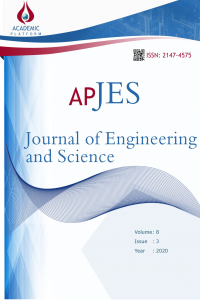Research Article
Year 2020,
Volume: 8 Issue: 3, 555 - 564, 30.09.2020
Abstract
Bu makalede, LS-DYNA sonlu elemanlar çözücüsü kullanılarak gerçekleştirilen dinamik simülasyonlarda, ağ örgüsü geometrik şeklinin, basıncın havadaki ilerleyişine ve büyüklüğüne etkisi incelenmiştir. İncelenen geometrik şekiller kübik, silindirik ve küresel olarak seçilmiştir. Dinamik simülasyonu modellemek için ALE metodu kullanılmıştır. Hedef bir noktadaki pik basınç değerleri, test sahasındaki dinamik testten elde edilen değer ile kıyaslanmıştır. Son olarak çalışmada belirtilen koşullarda hangi ağ örgüsü geometrik şeklinin daha doğru sonuçlar verebileceği değerlendirilmiştir.
Keywords
References
- [1] Hallquist, J., LS-DYNA keyword user’s manual – Version 970, Livermore Software Technology Corporation, Livermore, 2012.
- [2] G. F. Kinney and K. J. Graham, “Explosive Shocks in Air,” 1985.
- [3] J.O. Hallquist, LS-DYNA Theory Manual, Livermore Software Technology Corporation, California, USA, 2006.
- [4] B. Dobratz, “Properties of chemical explosives and explosive simulants,” 1972.
- [5] A. Erdik, S. A. Kilic, N. Kilic, and S. Bedir, “Erratum to: Numerical simulation of armored vehicles subjected to undercarriage landmine blasts,” Shock Waves, vol. 26, no. 4, pp. 531–531, 2016.
- [6] Z. S. Tabatabaei, J. S. Volz, J. Baird, B. P. Gliha, and D. I. Keener, “Experimental and numerical analyses of long carbon fiber reinforced concrete panels exposed to blast loading,” International Journal of Impact Engineering, vol. 57, pp. 70–80, 2013.
- [7] W. Xiao, M. Andrae, L. Ruediger, and N. Gebbeken, “Numerical prediction of blast wall effectiveness for structural protection against air blast,” Procedia Engineering, vol. 199, pp. 2519–2524, 2017.
- [8] A. Alia and M. Souli, “High explosive simulation using multi-material formulations,” Applied Thermal Engineering, vol. 26, no. 10, pp. 1032–1042, 2006.
- [9] M. S. Chafi, G. Karami, and M. Ziejewski, “Numerical analysis of blast-induced wave propagation using FSI and ALE multi-material formulations,” International Journal of Impact Engineering, vol. 36, no. 10-11, pp. 1269–1275, 2009.
- [10] G. F. Kinney and K. J. Graham, Explosive Shocks in Air. Berlin: Springer Berlin, 2014.
- [11] P. S. Bulson, “A history of research and a review of recent developments,” Explosive Loading of Engineering Structures, 1997.
- [12] T. Belytschko, D. Flanagan, and J. Kennedy, “Finite element methods with user-controlled meshes for fluid-structure interaction,” Computer Methods in Applied Mechanics and Engineering, vol. 33, no. 1-3, pp. 669–688, 1982.
- [13] W. Noh, “Cel: A Time-Dependent, Two-Space-Dimensional, Coupled Eulerian-Lagrange Code,” 1963.
- [14] N. Aquelet, M. Souli, J. Gabrys, and L. Olovson, “A new ALE formualtion for sloshing analysis,” Structural Engineering and Mechanics, vol. 16, no. 4, pp. 423–440, 2003.
- [15] P. Woodward and P. Colella, “The numerical simulation of two-dimensional fluid flow with strong shocks,” Journal of Computational Physics, vol. 54, no. 1, pp. 115–173, 1984.
Year 2020,
Volume: 8 Issue: 3, 555 - 564, 30.09.2020
Abstract
References
- [1] Hallquist, J., LS-DYNA keyword user’s manual – Version 970, Livermore Software Technology Corporation, Livermore, 2012.
- [2] G. F. Kinney and K. J. Graham, “Explosive Shocks in Air,” 1985.
- [3] J.O. Hallquist, LS-DYNA Theory Manual, Livermore Software Technology Corporation, California, USA, 2006.
- [4] B. Dobratz, “Properties of chemical explosives and explosive simulants,” 1972.
- [5] A. Erdik, S. A. Kilic, N. Kilic, and S. Bedir, “Erratum to: Numerical simulation of armored vehicles subjected to undercarriage landmine blasts,” Shock Waves, vol. 26, no. 4, pp. 531–531, 2016.
- [6] Z. S. Tabatabaei, J. S. Volz, J. Baird, B. P. Gliha, and D. I. Keener, “Experimental and numerical analyses of long carbon fiber reinforced concrete panels exposed to blast loading,” International Journal of Impact Engineering, vol. 57, pp. 70–80, 2013.
- [7] W. Xiao, M. Andrae, L. Ruediger, and N. Gebbeken, “Numerical prediction of blast wall effectiveness for structural protection against air blast,” Procedia Engineering, vol. 199, pp. 2519–2524, 2017.
- [8] A. Alia and M. Souli, “High explosive simulation using multi-material formulations,” Applied Thermal Engineering, vol. 26, no. 10, pp. 1032–1042, 2006.
- [9] M. S. Chafi, G. Karami, and M. Ziejewski, “Numerical analysis of blast-induced wave propagation using FSI and ALE multi-material formulations,” International Journal of Impact Engineering, vol. 36, no. 10-11, pp. 1269–1275, 2009.
- [10] G. F. Kinney and K. J. Graham, Explosive Shocks in Air. Berlin: Springer Berlin, 2014.
- [11] P. S. Bulson, “A history of research and a review of recent developments,” Explosive Loading of Engineering Structures, 1997.
- [12] T. Belytschko, D. Flanagan, and J. Kennedy, “Finite element methods with user-controlled meshes for fluid-structure interaction,” Computer Methods in Applied Mechanics and Engineering, vol. 33, no. 1-3, pp. 669–688, 1982.
- [13] W. Noh, “Cel: A Time-Dependent, Two-Space-Dimensional, Coupled Eulerian-Lagrange Code,” 1963.
- [14] N. Aquelet, M. Souli, J. Gabrys, and L. Olovson, “A new ALE formualtion for sloshing analysis,” Structural Engineering and Mechanics, vol. 16, no. 4, pp. 423–440, 2003.
- [15] P. Woodward and P. Colella, “The numerical simulation of two-dimensional fluid flow with strong shocks,” Journal of Computational Physics, vol. 54, no. 1, pp. 115–173, 1984.
There are 15 citations in total.
Details
| Primary Language | Turkish |
|---|---|
| Subjects | Engineering |
| Journal Section | Articles |
| Authors | |
| Publication Date | September 30, 2020 |
| Submission Date | February 12, 2020 |
| Published in Issue | Year 2020 Volume: 8 Issue: 3 |


